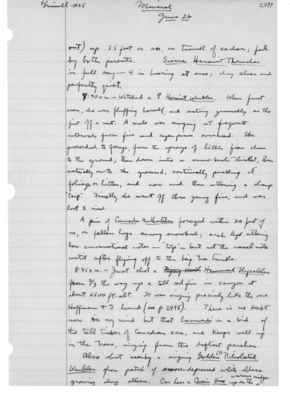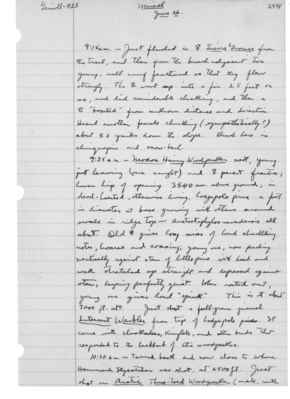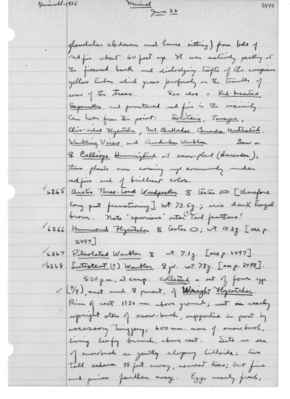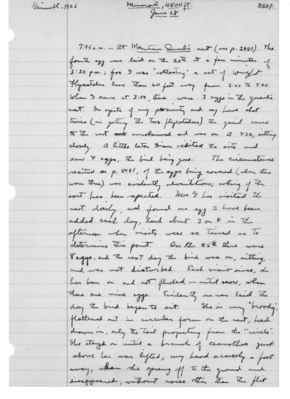Pages That Mention 1925-06-26
1925: Joseph Grinnell's field notes
S2 Page 43
Collector: Grinnell - 1925 Location: Mineral Date: June 26 Page Number: 2497
out) up 35 feet or so, on trunk of cedar; fed by both parents. Sierra Hermit Thrushes in full song - 4 in hearing at once, day clear and perfectly quiet.
7:40 a.m. - Watched a [female symbol] Hermit Warbler. When first seen, she was fluffing herself, and attacking generally as tho just off a nest. A male was singing at frequent intervals from fir and sugar pines overhead. She proceeded to forage, from the sprays of little fir close to the ground; then down into a snow-bush thicket, then actually on to the ground, continually picking at foliage or litter, and now and then uttering a sharp "tsip." Finally she went off thru young firs, and was lost to view.
A pair of Canada Nuthatches foraged within 20 feet of us, on fallen logs among snowbush; each kept uttering low conversational notes "Tiys" - but not the nasal note until after flying off to the big tree trunks.
8:45 a.m. - Just shot a Pygmy Nuth Hammond Flycatcher from 2/3 the way up a all red fir in canyon at about 6500 ft. alt. It was singing precisely like the one Hoffmann & I heard (see p. 2495). There is no doubt now in my mind but that hammondi is a bird of the tall timber of Canadian zone, and keeps well up in trees, singing from the loftiest perches.
Also shot a singing Golden ^(?) Pileolated Warbler from batch of snow-depressed white alders growing along the stream. Can hear a Cassin Vireo up on the ^warmer ridge.
S2 Page 44
Collector: Grinnell - 1925 Location: Mineral Date: June 26 Page Number: 2498
9:14 a.m. - Just flushed a [female symbol] Sierra Grouse from the trail, and then from the brush adjacent two young, well enuf feathered so that they flew strongly. The [female symbol] went up into a fir 25 feet or so, and did considerable clucking, and then a [male symbol] "boonted" from unknown distance and direction. Heard another female clucking (sympathetically?) about 50 yards down the slope. Brush here is chinquapin and snow-bush.
9:35 a.m. - Modoc Hairy Woodpecker nest, young just leaving (one caught) and [female symbol] parent frantic; lower lip of opening 3540 mm. above ground; in dead-hearted, otherwise living, lodgepole pine a foot in diameter at base growing with others around swale in ridge top - Arctostaphylos nevadensis all about. Old [female symbol] gives long series of loud chuckling notes, hoarse and coaxing; young one, now perching vertically against stem of little pine with head and neck stretched up straight and depressed against stem, keeping perfectly quiet. When routed out, young one gives loud "spink." This is at about 7000 ft. alt. Just shot a full-grown juvenal Lutescent Warbler from tip of lodgepole pines. It came with chickadees, Kinglets, and other birds that responded to the hubbub of the woodpeckers.
10:30 a.m. - Turned back and now close to where Hammond Flycatcher was shot, at 6500 ft. Just shot an Arctic Three-toed Woodpecker (male, with
S2 Page 45
Collector: Grinnell - 1925 Location: Mineral Date: June 26 Page Number: 2499
glandular abdomen and hence sitting) from bole of red fir about 60 feet up. It was actively pecking at the fissured bark and dislodging tufts of the conspicuous yellow lichen which grows profusely on the trunks of some of the trees. Saw also a Red-breasted Sapsucker, and punctured red fir in the vicinity. Can hear from this point: Solitaire, Tanager, Olive-sided Flycatcher, Mt. Chickadee, Canada Nuthatch, Warbling Vireo, and Audubon Warbler. Saw a [female symbol] Calliope Hummingbird at snow-plant (Sarcodes); these plants now coming up commonly under red firs and of brilliant colors.
6265 Arctic Three-toed Woodpecker [male symbol] testes [illustration] [therefore long past functioning] wt. 73.5g.; iris dark hazel brown. Note "spurious" outer ^(?) tail feathers!
6266 Hammond Flycatcher [male symbol] testes [illustration]; wt. 10.2g. [see p. 2497].
6267 Pileolated Warbler [male symbol] wt. 7.1g. [see p. 2497].
6268 Lutescent (?) Warbler [female symbol] jv. wt. 7.8g. [see p. 2498].
5:00p.m., at camp: collected a set of four eggs 4/4, nest and female parent, of Wright Flycatcher. Rim of nest 1130mm above ground; nest on nearly upright stem of snow-bush, supported in part by accessory twiggery; 600 mm. more of snow bush, living leafy branch, above nest. Site in sea of snowbush on gently sloping hillside; two tall cedars 75 feet away, nearest trees; but firs and pines farther away. Eggs nearly fresh;
S2 Page 46
Collector: Grinnell - 1925 Location: Mineral Date: June 26 Page Number: 2500
nest found ten days ago, barely began; 3 eggs in nest day before yesterday.
6269 Wright Flycatcher [female symbol] with set 4/4 11.0 g. Had evidently had an accident by which a lot of feathers on back were lost, there being now in process of replacement. Possibly, delayed nesting due to this accident.
June 27 4 p.m. - Cassin Vireo's nest: rim 1750 mm. above ground; nest near end of drooping cedar branch, 7 feet out ^(on south side) from trunk of tree, which is 15 inches in diameter 3 feet from ground. Site about 10 yards from edge of willow bog on one side and less distance from heavy stand of firs, on the other side; lodgepole pines bordering bog close by. This nest was found partly built on the 15th, empty but seemingly completed on the 20th, now with 4 fresh or nearly fresh eggs ^(two of them) and female incubating. Taken, set 2/4. Male bird sang awhile, then went away. After I had waited 20 minute, the [female symbol] came quietly, and I "collected" her.
5 p.m. - Traill Flycatcher nest and set 1/4, taken. Nest, not quite completed, found on 20th, now four eggs, nearly or quite fresh; birds close about me. Nest in dense willow jungle. Rim only 1040 mm. above running water of creek, here entirely overgrown with matted willows. Nest on slanting stems, overtopped by fully 5 feet of lush willow growth.
S2 Page 47
Collector: Grinnell - 1925 Location: Mineral, 4800 ft. Date: June 28 Page Number: 2501
7:45 a.m. - At Mountain Quail's nest (see p. 2481). The fourth egg was laid on the 20th at a few minutes of 2:30 p.m.; for I was "collecting" a set of Wright Flycatchers less than 60 feet away from 3:00 to 3:40. When I came at 3:00, there were 3 eggs in the quail's nest. In spite of my proximity and and my have [sic] shot twice (in getting the two flycatchers) the quail came to the nest and unobserved and was on at 3:30, sitting closely. A little later Dixon visited the site and saw 4 eggs, the bird being gone. The circumstance recited on p. 2481, of the eggs being covered (when there were three) was evidently adventitious; nothing of the sort has been repeated. Mrs. G has visited the nest daily, and found one egg to have been added each day, laid about 3 or 4 in the afternoon when visits were so timed as to determine this point. On the 25th there were 8 eggs, and the next day the bird was on, sitting, and was not disturbed. Each visit since, she has been on and not flushed - until now, when there are nine eggs. Evidently one was laid the day the bird began to sit. She is very "broody", flattened out in circular form on the nest, head drawn in, only the tail projecting from the "circle". She stayed on until a branch of ceanothus just above her was lifted, my hand scarcely a foot away, when she sprang off to the ground and disappeared, with noise other than the flit




